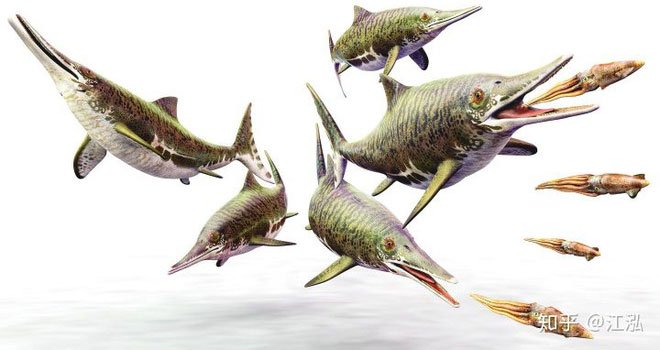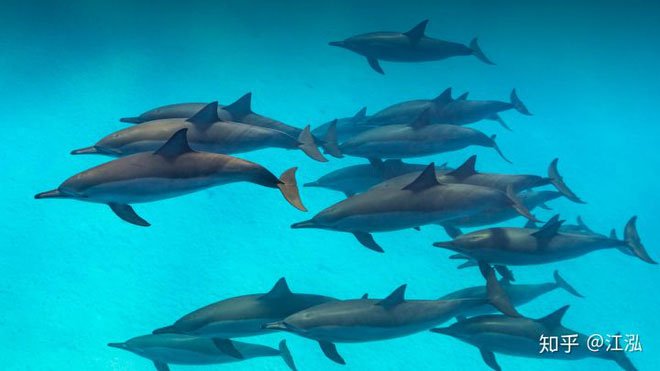Paleontologists discovered the fat on the body of the fish lizard 180 million years ago
Fat is something that always exists on an animal's body, but in fact they are very biodegradable and cannot exist in the form of fossils like bones , but recently paleontologists have recently found a trace. trace of fat on fossilized fish lizard in Germany. This discovery will raise our awareness of fish lizards.

Stenopterygius is an extinct genus of the ichthyizard Thunnizard known from Europe.This ichthyizard grows to a maximum length of 4 meters.

Dolphin.
Dolphins are mammals living in the ocean and waterways are closely related to whales. There are nearly 40 species of dolphins belonging to 17 genera living in the oceans, the remainder living in some rivers in the world. The size of dolphins can range from 1.2 m and 40 kg, up to 9.5 m and 10 tons.
Narrow-winged lizard - Stenopterygius lived 189 to 175 million years ago, early Jurassic, when people looked at their restorative images, people would mistakenly think that this is a dolphin because they have a shape similarly, like slender snout, rounded body, triangular dorsal fin, followed by well developed, caudal fin.
Although similar in appearance, the fish lizard belongs to the reptile and the dolphin belongs to the mammal , and they look like the result of evolutionary convergence.

Holzmaden is located in southern Germany.

Children dig fossils in Holzmaden.

Holzmaden 180 million years ago was a sea area, and that is also why there exists fossils of many prehistoric marine creatures.
Prehistoric Stenopterygius fish lizards lived throughout Western Europe, but the most sought after fossils were in Holzmaden, Germany.
Because of the discovery of fossils of marine life, we know that during the Jurassic period, millions of years ago, Holzmaden, located in southern Germany today, turned out to be an ocean. Tropic.
The fossils of narrow-winged lizard fish discovered in Holzmaden are famous for their delicate beauty, which not only preserves the complete skeleton but also traces of soft tissue, allowing us to see the outline of the fin. dorsal and caudal fins. The conservation of soft tissues plays an important role in more accurately restoring the appearance of this fish lizard.

Narrow-winged lizard fish fossils were found with the fossils of a shellfish.

Fossilized form of the most perfect narrow-winged lizard ever discovered.

The drawing restores the skeletal system of the narrow-winged lizard fish.
In addition to preserving the soft tissue structure of narrow-winged lizard fish, the fossil also revealed the mystery of its reproduction. Paleontologists found the remains of a narrow narrow winged lizard in the body of the mother Stenopterygius.
Initially, the researchers thought that the adult Stenopterygius would be inclined to eat small Stenopterygius so fossil samples often detect traces of the young offspring, but we don't know if it will. True or not until the fossil sample was discovered. As it turns out, the narrow-winged lizard fish and the whole lizard family are born from the ovule , which is a manifestation of their high adaptation to marine life.
An embryonic ovum is a mode of reproduction in an animal in which an embryo develops inside the egg and remains in the mother's body until they are ready to hatch, giving birth but not by pregnancy but by the egg. After fertilization stays in the fallopian tube until it hatches into an embryo, the embryo develops into the offspring thanks to the nutrients stored in the yolk, not from the mother's body. This mode of reproduction differs from the method of giving birth in that there is no placental connection between the mother and the baby and the body of the mother organism does not provide gas exchange (respiration).

Fossilized lizard fish always have a space between the bones and epidermis outside the muscle.
Johan Lindgren, a paleontologist at Lund University in Sweden, is an expert at studying marine reptiles in Mesozoic. He found that in many fossilized fish lizard species, there is always a space between the bones and the epidermis outside the muscles, which exist in large areas of soft tissue.
With the advancement of technology, especially the ability to test the composition of specific chemicals in fossils, Lindgren decided to study a fish lizard fossil that still preserves the soft tissue structure to find So what is that gap?

Fossil lizard fish.
Lindgren decided to go to the Urwelt-Museum Hauff Museum in Holzmaden, where there are many complete fossils of fish lizards. After searching through the fossils in the museum, he decided to choose fossil samples of the fish lizard code MH 432. As soon as the news came out, 23 scientists from around the world Lindgren's decision to join the research team. They want to learn the secrets of fish lizard fossils.

Narrow-winged lizard is a hot-blooded animal.
In fossil research, paleontologists found that there was subcutaneous tissue in the skin's residue, which was a layer of yellow fat. To further confirm, paleontologists compared subcutaneous tissue with today's dolphins and skin turtles and found that the structure was the same, suggesting that narrow-winged lizard fish have fat layers. The function of the grease layer is to retain heat, store energy and increase buoyancy. This "fat" layer from 180 million years ago proves that the narrow-winged lizard fish is a hot-blooded animal like the whales in the ocean today!
Although the shape of the Stenopterygius has been restored to a very precise level from before, their colors so far have been entirely speculative. Stenopterygius's fossils study not only found subcutaneous fat, but also melanocytes, which allowed scientists to determine their outer color.

Photo restored lizard fish narrow wings.
Studies have shown that the body color distribution of narrow-winged lizards is similar to today's marine life, with darker dorsal and lighter pigmented abdominals. This body color distribution is not only convenient for hiding the body but also helps them to adjust body temperature more easily.

Ancient narrow winged lizards.
- Discover the extinct fish lizard 25 years ago
- Dragon fossil 200 million years intact embryo
- Mexico: Lizard discovered 23 million years old
- 200 million year long sea fossil remains intact
- Discovered an ancient snake-headed lizard
- Dog sniffs see ancient fish lizard fossils
- Discovered flying lizards that lived 125 million years ago in China
- Discovered dinosaurs never known in Argentina
- Found tiny lizard legs in amber 20 million years old
- Detecting sea lizard fossils 75 million years
- 200 million-year-old sea lizard fossils discovered
- Colombian boy goes out, finds fossil 90 million years old
- Why are some fish species extinct 65 million years ago
- Detecting fossil prehistoric monsters died during childbirth
 Discovered an ancient centipede fossil 99 million years old
Discovered an ancient centipede fossil 99 million years old Discovered bat-like dinosaurs in China
Discovered bat-like dinosaurs in China Discovered a 200-year-old bronze cannon of the coast
Discovered a 200-year-old bronze cannon of the coast Discover 305 million-year-old spider fossils
Discover 305 million-year-old spider fossils